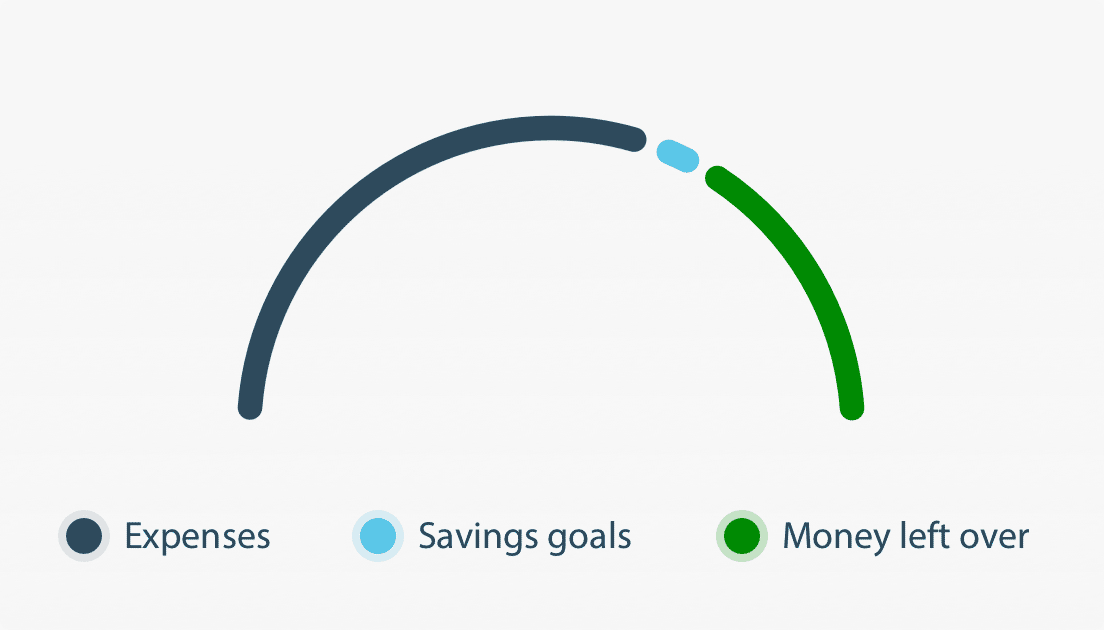Fraud protection.
Now it’s personal.
ANZ Falcon® technology monitors millions of transactions every day to help keep you safe from fraud.
Falcon® is a registered trademark of Fair Isaac Corporation.
Here are four practical steps, with tips and insights, to help you get on top of your money.
Read through the steps below, pull out any gold nuggets (sorry, not literally) and reconnect with your spending, saving and splurging. Remember, do what's right for you and your financial circumstances.

Here's the thing - it's not just about how much you have, but also learning how to manage it.
![]()
Finding a balance between what you need, and what you really, really want, is what makes a budget work. Go through your most recent bank statement, ask yourself some tough questions, and divide your expenses into “wants” and “needs”, based on what’s actually important to you. The needs will have to stay, but could some of the wants get the chop?
![]()
This easy 50-30-20 budget ratio moves with you. It’s based on percentages and not how much you earn, so it’s a great way to discover where you can trim your expenses, and keep working towards your saving goals at the same time.
It works by splitting your monthly income into three buckets:
Remember, nobody’s buckets look the same. Take into account your own unique circumstances when dividing up your expenses. You set the limits you live by.
![]()
It’s time to put pen to paper, or fingers to keys, and reset your budget. Look at your income and expenses over the past year (or at least the past few months) to track how much you’ve got coming in and how much you need for your essential costs - think debts, bills, food, education, insurance, etc. Then, work out what you’ll have left over each month and how much you could put into savings. Want a shortcut? Use the ANZ Budget Planner below and download a copy when you’re done!

The ANZ Budget Planner is a tool provided for illustrative purposes only. The results generated by using the ANZ Budget Planner tool are based only on the information you have provided, and are not stored by ANZ.
Want to be more accurate? Having the following on hand will help:
![]()
Your budget’s not just what you’ve got coming in, it's about learning how to manage where it goes. And that means making sure you’ve stuck to it! Use your transaction history or a spending tracker to help you monitor your expenses on the run.
To make it even easier, most banks have a spend-tracking feature built right into their app – such as ANZ Spendi in the ANZ App, where you can set a daily budget on an account, then ANZ Spendi will show you daily spending at a glance, bonus emojis included.
![]()

We’re all about budgeting smarter, not harder, and looking for ways to reduce, reuse or renegotiate some of your essential spending.
![]()
Reducing your costs doesn’t always have to come with extreme sacrifice. Sometimes, it’s just about changing providers to save a couple of dollars every day, or reconsidering what type of plan you need for a particular service.
Here are some products and providers you may want to take a second look at:
Mobile phone plan
Insurances - health, car, life, pet, home, etc
Electricity or gas provider
Internet plan
Gym membership
![]()
Becoming more conscious of what you’re using, or investing in greener solutions, could provide cost benefits in the long term. Here are some going green tips to take a look at:
![]()

No one likes a lurking subscription that you’ve entirely forgotten about – but getting rid of them is an easy savings win! Audit your monthly debits and make some big calls about which ones you’re really getting value from. Start with:
A subscriptions sweep could be a savings goldmine when you’re looking to cut your costs and find hidden savings.
![]()

It’s near impossible to cut your spending entirely, but you can be extra aware of where your hard-earned money goes.
It all adds up, and it’s worth treading carefully instead of spending without a second thought. You don’t have to be restrictive, you can just get a little savvier.
![]()
Keeping your grocery costs to a minimum can be a massive savings win. And you don’t have to ruin what you love about your shopping list in order to cut back. Marinated goat's cheese anyone? Here are some savvy supermarket hacks:
![]()
Very few things in life are free, but a lot of things are on special. Look out for savings and deals on your weekly shop and tap into the world of discount codes, coupons and loyalty cards. Use cheap ticket nights. Download apps that give member discounts. Subscribe to all the newsletters and be the first to hear about sales.
![]()
Bring attention to your spending habits by stopping and making a more conscious decision before you tap your card. Try these mindful spending tips to keep your spending…well, in mind!
Celebrate your savings wins along the way to keep you motivated and working towards your goals.
![]()
Did you know that approximately 22% of Australians have no savings, at all?
If this year has taught us anything, it’s that it might be time to prepare for the day the ground shifts beneath you, whether that’s an accident or sickness, or a global economic recession.
![]()
It really depends on how much rain you’re expecting. You could aim for six months’ worth of essential expenses as a minimum, but keep in mind your ongoing expenses and level of debt repayments. Remember, even starting with the smallest amount can help. Research shows that having just $1,000 in the bank as a buffer can make a huge difference to your financial wellbeing.
![]()
Even a small savings contribution can have a major impact in the long term. Take a look at how much you’d need to save each fortnight to get to $10k within the next few years:
 |
 |
 |
![]()
There’s no need to crack open your umbrella if it isn’t raining. Some events that could call for dipping into your savings include:
![]()
To help your savings grow even faster, set it aside the day you get paid. You could even set up automatic monthly transfers so you don’t have to think about it. It’s like it was never there…
From $1,000 to $10,000 we all have a magic number we want to save for a rainy day. See how long it will take you to get there.

Packed with tools and tips, the full six step ANZ Financial Wellbeing Program will help you improve your financial behaviours. Step one? Find out your Financial Wellbeing Score!
We may be able to provide you with assistance depending on your circumstances.
Eligible participants can develop a savings habit with this matched savings program.
![]()
The information set out above is general in nature and has been prepared without taking into account your objectives, financial situation or needs. Before acting on the information, you should consider whether the information is appropriate for you having regard to your objectives, financial situation and needs. By providing this information ANZ does not intend to provide any financial advice or other advice or recommendations. You should seek independent financial, legal, tax and other relevant advice having regard to your particular circumstances.
The ANZ Budget Planner is a tool provided for illustrative purposes only. The results generated by using the ANZ Budget Planner tool are based only on the information you have provided. It does not constitute a quote or financial advice, and ANZ does not endorse or approve any budget created using the ANZ Budget Planner. Before considering if any product is right for you, you should take into account your objectives, personal needs and financial circumstances and consider whether it is appropriate for you.
ANZ does not use the information you provide for the purpose of assessing any application.
The ANZ App is provided by Australia and New Zealand Banking Group Limited (ANZ) ABN 11 005 357 522. Super, Shares and Insurance (if available) are not provided by ANZ but entities which are not banks. ANZ does not guarantee them. This information is general in nature only and does not take into account your personal objectives, financial situation or needs. ANZ recommends that you read the ANZ App Terms and Conditions available here for iOS and here for Android and consider if this service is appropriate to you prior to making a decision to acquire or use the ANZ App.
ANZ App for Android is only available on Google Play™. ANZ App for iPhone is only available from the App Store.
Apple, Apple Pay, Apple Watch, Face ID, iPad, iPhone and Touch ID are trade marks of Apple Inc., registered in the U.S. and other countries. App Store is a service mark of Apple Inc. Android, Google Play and the Google Play logo are trade marks